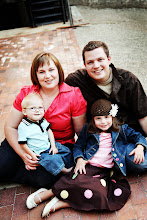What a great way to say that my child is trying to breath at night but simply can't get enough air in his lungs to do the job. It is frightening in a child like Nathan because it can lead to pulmonary hypertension (where we already know that the pulmonary valve isn't going to hold out forever).
This is an excerpt from an article that talks about children with obstructive sleep apnea.
Children with Craniofacial Syndromes
JAMES CHAN, M.D., Cleveland Clinic Foundation, Cleveland, Ohio
JENNIFER C. EDMAN, M.D., Fairview Hospital, Cleveland, Ohio
PETER J. KOLTAI, M.D., Cleveland Clinic Foundation, Cleveland, Ohio
"OSA is more common in children with craniofacial syndromes. Children who have syndromes with craniosynostosis, such as Apert's syndrome, Crouzon's disease, Pfeiffer's syndrome, and Saethre-Chotzen syndrome; abnormalities of the skull base; and accompanying maxillary hypoplasia may have nasopharyngeal obstruction. Children with syndromes that involve micrognathia, such as Treacher Collins syndrome, Pierre Robin syndrome, and Goldenhar's syndrome, become obstructed at the hypopharyngeal level. In children with trisomy 21, a narrow upper airway combined with macroglossia and hypotonic musculature predisposes them to OSA.
The surgical management of craniofacial syndromes and OSA in children frequently requires more than standard adenotonsillectomy. Tracheotomy often is necessary. In children with midfacial hypoplasia, craniofacial advancement may be indicated. Glossopexy, mandibular distraction or advancement, or tongue suspension should be considered in patients with micrognathia.30"
Basically, because of Nathan's craniofacial abnormalities, he was at a serious increase risk of having apnea. This is in part of his micrognathia and cleft hard & soft palates. Since his jaw has already been advanced and his tonsils and adenoids are actually not that big (as well as an excellent defense against germs) we have opted not to have him operated on again. We've also decided that we don't want his tongue stitched down to his lip to keep it from blocking his airway. We had also discussed using a dental appliance to help with the apnea, however, Dr. Yamashiro (the orthodontist) feels that this is only particularly helpful to those with mild to moderate apnea. This would also be very difficult to keep in Nathan's mouth. With Nathan's specific needs, Dr. Daftery, Dr. Park, and I have decided that the BiPap would be the first measure we'd take in correcting this problem.
This is not a CPap Machine! Here is the difference:
What is a CPAP Machine?
"Continuous Positive Airway Pressure, also known as CPAP is a method of take positive pressure and applying it inside the throat in order to keep it from collapsing while you are sleeping. The mask is hooked up to this machine and it is worn over the nose and is connected to a CPAP pump. This pump then applies pressure to the throat through the mask in order to keep your throat from collapsing. While many people tend to stop using their mask within the first year, finding a mask that fits and feels comfortable can provide a solution to this problem. Usually these masks are made out of silicon and it then makes a seal over your nose. New gel filled masks are also available, and many people find them more comfortable
What is a BIPAP Machine?
The BIPAP machine is also a breathing machine designed to help patients breath easier. Not only does this machine help to push some air into the lungs, but it also helps to get more oxygen into the lungs by holding them open. This machine is adjustable and can sense the amount of pressure to use when exhaling and inhaling. The mask that goes along with this machine goes simply over the face, usually the mouth and nose, and creates a seal so the air pressure goes into your body.
When to Use These Masks
If you happen to have Obstructive Sleep Apnea, then more than likely you’ll want to use the CPAP machine, since it is great for people who deal with mild Obstructive Sleep Apnea. Most people who use these machines regularly see great improvement and it can be adjusted in such a way to make sure that normal breathing is restored while you are sleeping. However, a person who has severe problems with emphysema should never use a CPAP machine.
Many doctors actually use BIPAP machines for patients who are not totally able to breath on their own. This helps to get more oxygen in their blood. Of course BIPAP machines are also used to treat sleep apnea. This is usually a treatment for those who have more severe apnea problems or for those who have a hard time dealing with the CPAP machines. The machines also help to prevent snoring as well.
The Difference Between the Two
So, what is the real difference between CPAP ventilation masks and BIPAP ventilation masks? Well, the difference is actually quite simple. The CPAP machines apply continuous pressure to the airways and have only one level of pressure. However, the BIPAP machines have two different pressures. Higher amounts of pressure are applied when the patient is breathing in, while lower pressure is used when they are breathing out. Both machines do well for treating mild to moderate obstructive sleep apnea; however, the BIPAP machines are better for severe obstructive sleep apnea and also are effective in treating central sleep apnea as well.
So, as you can see, both types of machines can be extremely useful for treating sleep apnea. Many suffers of sleep apnea actually end up preferring the BIPAP machines, and it is easy to see why. Instead of dealing with that constant pressure that CPAP machines use, the pressure of the BIPAP machines vary, while you are inhaling and exhaling.
Jason R Davidson owns and operates http://www.cpapreview.net - CPAP Visit the site for more product reviews and information on how to get the best from your CPAP equipment check.
Nathan is trying to actually breathe on his own, but he isn't able to get enough air intake that a CPAP would not work for him. That's why he is using a BiPap machine instead.
This is Nathan with his BiPap machine. He actually did really well not trying to pull it off of his face. Poor kid is supposed to wear this every night indefinitely (with his helmet). He doesn't really like it, but once he's asleep its not that bad. Now if only the alarm would stop sounding every 5 minutes.....

Our newest member of our household: The BiPap Machine. Some people get pets; we could the latest and greatest home health care machines!




.jpg)






1 comment:
All these things that little Nathan has to endure, which means that you also have to endure on the sidelines. He is an amazing baby to deal with these trials and yet seems to take it so well. I hope that things will eventually get better as he adjusts to the BiPap machine and that you can get some sleep.
Post a Comment